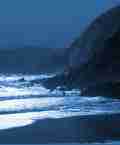 |
Search the site:

Walking Irelandís MountainsDONEGALNorth of the Highlands, some of the headlands facing the Atlantic, particularly Horn Head, give good cliff and coastal, rather than mountain, walks (routes 57, 58). The Inishowen Peninsula, farther east, bears the imprint of the south-west to north-east orientation of the Highland. The hills here cover smaller areas and are lower, rising to 615 metres/ 2,019 feet at Slieve Snaght (Inishowen), which is unfortunately surrounded by moorland (route 51). The tiny range of rocky serrated hills cut by the rugged Gap of Mamore (route 52) makes for far more diverse walking.The other mountains of Donegal are to the south of the county and are separated from those farther north by bleak moorland which has only a few good distinct peaks (route 53). In the remote south-west the great bulge of wild land sometimes called Rossaun, to the north of Donegal Bay, yields a stupendous cliffscape at Slieve League (595 metres/ 1,972 feet) (route 54), which plunges from summit to ocean in mighty cliffs. There are some very remote cliff walks from Glencolumbkille north and east to Ardara (route 63) and some interesting country near the glacial valley of Glengesh (route 55). The remainder of the peninsula is not so interesting. Farther east, north of Donegal town, are the Blue Stacks (routes 56, 62). They are guarded by exceptionally wet bogland whose waters augment the streams fed by foaming cascades from the several lakes of the interior. Luckily, the Donegal Way, which penetrates the range, is a handy means of access, though even it is usually quite soggy. The range itself is fairly small (about twenty kilometres/ twelve miles long), with high points (they hardly qualify as peaks) which reach about 640 metres/ 2,100 feet. Signs of man (e.g. fences or walls) are notably absent. The range consists mainly of subdued granite country, sometimes in the form of huge pink granite slabs. This otherwise gently sloping terrain is broken by many low and some not so low cliffs. Because of its complicated terrain of irregular and unexpected cliffs and indeterminate peaks, good navigational skills are required, so the new 1:50,000 Discovery Series map is particularly welcome. Access: the region is quite far from ferry ports and this difficulty is exacerbated by the generally bad state of Donegal's roads. Dublin is about 240 kilometres/ 150 miles from Letterkenny, and Larne is about 170 kiiometres/ 105 miles away. There is an airport in Derry which is fairly close to the north-east of the region. There are no express bus services within North Donegal. A frequent express service runs between Donegal and Letterkenny and a once-a-week service runs west from Donegal town to Glenties in Rossaun. Transport and accommodation in North Donegal: the NS6 rounds the Highlands on three sides, linking a string of villages and small towns, any of which might act as a modest centre, though none is ideal for all areas. Creeslough, Dunfanaghy and Falcarragh are probably the best situated along the coast, and tiny Dunlewy the best inland. R-roads traverse parts of the valleys between the ranges but are circuitous and winding. The Lough Swilly Bus Company has an infrequent service along the coast which may be a help in devising A to B routes. Its present schedule, westward in the morning, particularly suits routes on the east of the Errigal - Muckish range. This company also serves Inishowen, where there are several seaside resorts to serve as small bases. Transport and accommodation in South Donegal: there are only small villages in remote Rossaun - Glencolumkille is the best known; however, visitors will find at least modest accommodation everywhere. The roads on the peninsula are fairly poor, though access to the south of the Blue Stacks is quite good. Donegal, a comparatively large town, is the best centre for the Blue Stacks and indeed much of Rossaun. There are good local services west from Donegal town to Glencolumbkille and Glenties and an infrequent one beyond Glencolumbkille to Malinmore. There is also a good service through the Barnesmore Gap close to the Blue Stacks. The next 'Donegal' extract can be found here : Part 3 The previous 'Donegal' extracts from Walking Ireland's Mountains can be found here: Part 1 |
|
[ Back to Top ]
All Material © 1999-2009 Irelandseye.com and contributors
